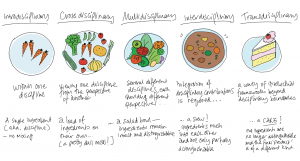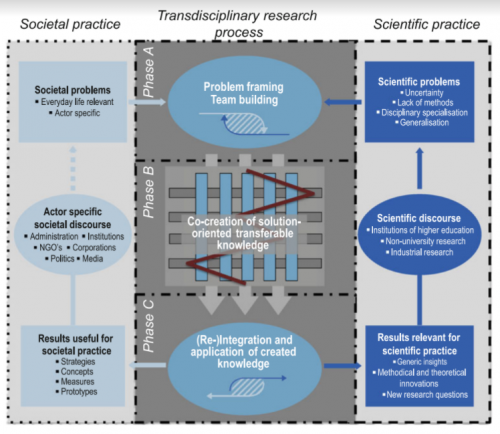Difference between revisions of "Transdisciplinarity"
| Line 5: | Line 5: | ||
To understand transdisciplinarity, it should first be distinguished from multidisciplinarity and interdisciplinarity. This is especially relevant when comparing German-speaking and English-speaking resources: the US-American understanding of transdisciplinarity is rather comparable to interdisciplinarity, while the German-speaking discourse is based on the following distinctions. | To understand transdisciplinarity, it should first be distinguished from multidisciplinarity and interdisciplinarity. This is especially relevant when comparing German-speaking and English-speaking resources: the US-American understanding of transdisciplinarity is rather comparable to interdisciplinarity, while the German-speaking discourse is based on the following distinctions. | ||
| − | [[File:Disciplinary. | + | [[File:Disciplinary.png|300px|thumb|right|'''Different forms of disciplinary cooperation.''' [http://makinggood.design/thoughts/tasty/ Source.]]] |
* '''Multidisciplinarity''' revolves around the cooperation between different academic disciplines for one research endeavour. The researchers study the same topic in a parallel structure and all have their distinct goals and research questions. They share knowledge and compare their findings and may also combine their results in one big report, but the disciplinary boundaries are not transgressed. (Stock & Burton 2011) | * '''Multidisciplinarity''' revolves around the cooperation between different academic disciplines for one research endeavour. The researchers study the same topic in a parallel structure and all have their distinct goals and research questions. They share knowledge and compare their findings and may also combine their results in one big report, but the disciplinary boundaries are not transgressed. (Stock & Burton 2011) | ||
* '''Interdisciplinarity''' is a research mode that deploys a higher level of cooperation between researchers from different, often rather unrelated disciplines. Disciplinary viewpoints are crossed and integrated to develop new perspectives in order to create new knowledge or re-assess existing, disciplinary knowledge. As an example, political scientists and ecologists may come together to jointly study a eco-political issue. (Stock & Burton 2011) | * '''Interdisciplinarity''' is a research mode that deploys a higher level of cooperation between researchers from different, often rather unrelated disciplines. Disciplinary viewpoints are crossed and integrated to develop new perspectives in order to create new knowledge or re-assess existing, disciplinary knowledge. As an example, political scientists and ecologists may come together to jointly study a eco-political issue. (Stock & Burton 2011) | ||
Revision as of 12:50, 28 September 2020
Transdisciplinarity is a research approach that is commonly applied in Sustainability & Transformation Research. The following entry introduces the approach, its characteristics and prevalent challenges, and illustrates the use of methods with examples.
Contents
Multi-, Inter- and Transdisciplinarity
To understand transdisciplinarity, it should first be distinguished from multidisciplinarity and interdisciplinarity. This is especially relevant when comparing German-speaking and English-speaking resources: the US-American understanding of transdisciplinarity is rather comparable to interdisciplinarity, while the German-speaking discourse is based on the following distinctions.

- Multidisciplinarity revolves around the cooperation between different academic disciplines for one research endeavour. The researchers study the same topic in a parallel structure and all have their distinct goals and research questions. They share knowledge and compare their findings and may also combine their results in one big report, but the disciplinary boundaries are not transgressed. (Stock & Burton 2011)
- Interdisciplinarity is a research mode that deploys a higher level of cooperation between researchers from different, often rather unrelated disciplines. Disciplinary viewpoints are crossed and integrated to develop new perspectives in order to create new knowledge or re-assess existing, disciplinary knowledge. As an example, political scientists and ecologists may come together to jointly study a eco-political issue. (Stock & Burton 2011)
-
Transdisciplinarity, then, can be seen as the next higher step. Transdisciplinarity is "a reflexive, integrative, method-driven scientific principle aiming at the solution or transition of societal problems and concurrently of related scientific problems by differentiating and integrating knowledge from various scientific and societal bodies of knowledge." (Lang et al. 2012, p.26f). The most important features here are
- the collaboration of academia and society in a mutual learning and research process where stakeholders (politicians, entrepreneurs, NGO representatives, citizens etc.) are involved at all stages, i.e. in the framing of the problem, the development of possible solutions and the creation of new scientific knowledge, with a focus on these stakeholders contributing their specific knowledge and experiences to broaden the research perspective;
- the focus on real-world problems, such as questions of sustainable development, that strongly affect and interest not only the academic sphere, but also the economy, culture and politics; as well as
- the development of solutions to the studied problems that are transferable both into scientific and practical discourses and action. (Stock & Burton 2011, Lang et al. 2012, Arnold & Piontek 2018, Mauser et al. 2013; Ruppert-Winkel et al. 2015).
Why should (Sustainability) Science engage with the public?
Throughout the last centuries and decades, the differentiation and institutionalisation of scientific disciplines allowed academia to develop and deepen specified conceptual and methodological expertise and create distinct language and topics that have enabled these disciplines to provide plenty of insightful knowledge and guidance for society (Stock & Burton 2011). However, there has been an increasing recognition that disciplinary viewpoints and approaches may no longer be sufficient to solve prevalent challenges that span across several scientific and societal spheres. Examples for this are ecological threats such as biodiversity loss or socio-technological challenges such as digitalisation which demand the creation of new theoretical and empirical scientific insights, but also action-oriented solutions that can be applied in policy, business, education, culture and such. With his landmark 1994 publication, Michael Gibbons introduced the term "Mode 2 research" which highlights this emerging form of scientific inquiry that is "characterised by closer interaction between scientific, technological and industrial modes of knowledge production, by the weakening of disciplinary and institutional boundaries, by the emergence of more or less transient clusters of experts, often grouped around large projects of various kinds, and by the broadening of the criteria of quality control and by enhanced social accountability." (Gibbons 1994, p.68)
To this end, multi- and interdisciplinary research modes (see above) are research modes that cross disciplinary boundaries, but transdisciplinary research best represents this new form of knowledge production. Mode 2 research and transdisciplinary research have therefore often been used synonymously. Transdisciplinary research facilitates the creation of not only system knowledge (the current state) and target knowledge (the intended state), but especially of transformational knowledge (how to get there) that considers the demands and preconditions of all relevant stakeholders. Thus, transdisciplinary research is of particular interest where there is a lack of practical knowledge about a specific problem, solution pathways are not yet known and there is a need for societal negotiation throughout the development of solutions. (Arnold & Piontek, p.145f)
Transdisciplinary research is of special importance to Sustainability Science and has received immense recognition in this field in the last years. This is because "[s]ustainability is also inherently transdisciplinary" (Stock & Burton 2011, p.1091), as it builds on the premise of solving real-world problems which are deeply nestled in ecological, political, economic and social processes and structures and therefore cannot be understood and solved without engaging with these spheres (Kates et al. 2015). Transdisciplinary research is a suitable approach for Sustainability Science as it allows to incorporate the knowledge of relevant stakeholders; considers the normative dimensions involved in societal endeavours, namely diverging norms, goals and visions of different societal spheres; and increases legitimacy, ownership and accountability for the jointly developed solutions. (Lang et al. 2012; Stock & Burton 2011). The integrative transdisciplinary approach highlights systemic interdependencies, enables a better understanding of complex issues and provides better knowledge to develop socially robust and applicable, effective solutions (Lang et al. 2012; Mauser et al. 2015).
How to do TD in Sustainability Science
Here, we will refer to the ideal-typical model presented by Lang et al (2012). It introduces a conceptual guide, structured into three phases, on how transdisciplinary research for sustainability science should ideally be conducted. The relevant steps of each phase as well as general principles for the whole process will be listed below. The presented process is recursive: Problems emerging in scientific as well as societal practice are integrated in the transdisciplinary research approach. After its three phases have been realized, the newly generated knowledge and solutions are re-integrated into these two spheres, where they are applied and consolidated. Ultimately, new challenges emerge that demand renewed transdisciplinary collaboration.
The ideal-typical model
Phase A
- Build a collaborative research team.
- Create joint understandings and definitions of the problem.
- Collaboratively define research objects and objectives, research questions, and success criteria.
- Design a methodological framework.
Phase B
- Assign roles and responsibilities.
- Apply research methods and settings to create the intended knowledge.
Phase C
- Realize two-dimensional integration.
- Generate products for both parties (societal and scientific).
General principles
- Facilitate continuous evaluation
- Mitigate conflict constellations
- Enhance capabilities for and interest in participation
Challenges
There is a wide range of challenges that transdisciplinary research is confronted with, and which makes the achieval of the ideal-typical model challenging.
- Mauser et al. (2013) remark that the roles and responsibilities of all stakeholders involved need to be clarified from the beginning and existent inequalities need to be removed. Further, they comment that integrated research modes demand new methods and concepts, new institutional arrangements, organizational competencies and tailored funding possibilities. The cooperation between science and society require reflexive learning processes, appropriate communication tools and also reflect on the role of science in the overall endeavour. Also, they highlight that there may be inertia to change which needs to be overcome.
- Lang et al. (2012) name various issues in the framing of problems (lack of problem awareness, unbalanced problem ownership), processual issues (insufficient legitimacy of the actors involved, conflicting methodological standards, lack of integration (knowledge, structures, communication), discontinuous participation), as well as challenges concerning the development of solutions (ambiguity of results, fear to fail, limited solution options, lack of legitimacy of transdisciplinary outcomes, capitalizing on distorted research results, issues when tracking impacts). Also, "[a]rguing from a more conventional research perspective, scientists might be skeptical with respect to reliability, validity, and other epistemological and methodological aspects of collaborative research (‘‘credibility’’). Practitioners and stakeholders, on the other hand, might be skeptical regarding the practical relevance of the results (‘‘salience’’)." (Lang et al. 2012)
- Hall & Rourke (2014) expand on communicative challenges, claiming that "[n]ot all of the challenges that threaten TDSS [transdisciplinary sustainability science] are communication challenges, but communication breakdown can exacerbate any of them. Because of its centrality, care must be taken by collaborators to cultivate a healthy communication dynamic; however, given the many perspectives involved in a typical TDSS project, this will not be easy. These projects meet complex problems with complex responses, entailing the need to remain flexible and responsive to participant requirements and the need to modify the approach if new information and values arise." They name communicative challenges especially in the framing of problems (exclusion of important perspectives, different view of the problem) and the conduction of the research (unwillingness to share personal perspecctives, failure to recognize or articulate differences in individual assumptions, uncertainties and incomplete or incompatible knowledge, limited cognitive abilities to integrated individual partial knowledge).
Methods of transdisciplinary research
Several scientific methods are useful for transdisciplinary work. Many methods used in TD research represent single elements of a broader transdisciplinary inquiry, such as interviews which may be used in a first step of consultation. Other methods, however, originate from transdisciplinary endeavours or are strongly associated to them. Among these, noteworthy methods include:
- Visioning as well as Scenario Planning favor transdisciplinary research.
- Living Labs & Real-World Laboratories as research environments that facilitate transdisciplinary research.
- Social Network Analysis can help identify structures and issues in real-world contexts.
- Citizen Science can also be transdisciplinary.
Skills & Tools
Various Skills & Tools may facilitate transdisciplinary research and help solve some of the challenges mentioned above. Among these are:
Agency
The choice of methods for TD research is also relevant for the level of agency that is provided to the non-scientific stakeholders in the process. One may differentiate four levels of agency on which societal actors are involved in scientific research:
- Information: Stakeholders are informed about scientific insights, possibly in form of policy recommendations that make the knowledge actionable. This is the most common form of science-society cooperation.
- Consultation: Stakeholders provide information of interest to the researchers, e.g. in form of interviews. They are sources of information, but are not actively engaged in the scientific process.
- Collaboration: Stakeholders cooperate with academia, e.g. through one of the aforementioned methods, in order to jointly frame and solve a distinct issue.
- Empowerment: Stakeholders are enabled to tackle issues by themselves and are provided ownership for problems and their solution. Empowerment exceeds simple collaboration in that it creates skills for stakeholders to engage with problems on their own instead of involving academia anew for every arising issue.
To illustrate the choice of methods in transdisciplinary research, how the selected methods can be combined, and how they relate to agency, see one of the following examples.
Examples

- The research project "Besatzfisch" is a good example of a long-term transdisciplinary research project that engages with different methodological approaches. This four year project attempted to understand the ecological, social and economic role and effects of stocking fish in natural ecosystems. Several research steps were deployed:
- First, fish was introduced to ecosystems and the subsequent population dynamics were qualitatively & quantitatively measured, much of this jointly with the cooperating anglers. (Cooperation)
- Second, anglers were questioned about fish population sizes and their economic implications (Consultation) before the data was analyzed using monetary modelling.
- Third, decision-making processes were modelled based on conversations with anglers, and their mental models about fishing were evaluated (Consultation).
- Fourth, participatory workshops were conducted to help anglers optimize their fishing grounds (Empowerment).
- Fifth, social-ecological models were developed based on the previous empirical results. (Consultation)
- Sixth, the project results are published in different forms of media for different target groups (Information).

Open questions and future directions
The future of transdisciplinary research is promising. However, major hurdles still need to be overcome. These include
- the question how willing academia is to leave the proverbial 'ivory tower' and get in contact with political, economic and societal actors
- the need for more experiences and practical guidance on how the aforementioned challenges in the conduction of transdisciplinary research can be solved (integration of knowledge, balancing of interests and methods, communication and mutual learning, joint development of solutions)
- ducational approaches that support transdisciplinary thinking and working
"As the world’s natural resources dwindle and the climate changes, the need for sustainability research will increase—as will the need for both integrated research and clear frameworks for conducting such research. Research on sustainability is vital to our collective interests and will require more and more collaboration across various boundaries. The more clearly we can articulate the bridges between those boundaries, the easier those novel collaborations will be." (Stock & Burton 2011, p.1106)
Key Publications
Lang et al. 2012. Transdisciplinary research in sustainability science: practice, principles, and challenges.
Defila, R. Di Giulio, A. (eds). 2018. Transdisziplinär und transformativ forschen. Eine Methodensammlung. Springer VS.
Brandt et al. 2013. A review of transdisciplinary research in sustainability science. Ecological Economics 92. 1-15.
GAIA Special Episode Labs in the Real World - Advancing Transdisciplinarity and Transformations.
Gibbons, M. (ed.) 1994. The new production of knowledge: The dynamics of science and research in contemporary societies. SAGE.
References
Lang et al. 2012. Transdisciplinary research in sustainability science: practice, principles, and challenges.
Kates et al. 2015. Sustainability Science.
Stock, P. Burton, R.J.F. 2011. Defining Terms for Integrated (Multi-Inter-Trans-Disciplinary Sustainability Research). Sustainability 3. 1090-1113.
Arnold, A. Piontek, F. Zentrale Begriffe im Kontext der Reallaborforschung. in: Defila, R. Di Giulio, A. (eds). 2018. Transdisziplinär und transformativ forschen. Eine Methodensammlung. Springer VS.
Gibbons, M. (ed.) 1994. The new production of knowledge: The dynamics of science and research in contemporary societies. SAGE.
Mauser et al. 2013. Transdisciplinary global change research: the co-creation of knowledge for sustainability. Current Opinion in Environmental Sustainability 5. 420-431.
Ruppert-Winkel et al. 2015. Characteristics, emerging needs, and challenges of transdisciplinary sustainability science: experiences from the German Social-Ecological Research Program. Ecology and Society 20(3). 13-30.
Hall, T. E. O'Rourke, M. 2014. Responding to communication challenges in transdisciplinary sustainability science. Heuristics for transdisciplinary sustainability studies: Solution-oriented approaches to complex problems. 119-139.
Further Information
- The INTREPID network revolves around transdisciplinary and interdisciplinary research and provides useful actors and learnings in this field.
- TD-NET is a resourceful Swiss platform that organizes and presents activities in the field. The same can be said about the Complexity or Control blog, hosted at Leuphana University.
- The Reallabor-Netzwerk also hosts useful information about real world laboratories and transdisciplinary research.
- Mauser et al. (2013, p.420) present the Future Earth Initiative, which emerged from Rio+20 and "will provide a new platform and paradigm for integrated global environmental change research that will be designed and conducted in partnership with society to produce the knowledge necessary for societal transformations towards sustainability".
